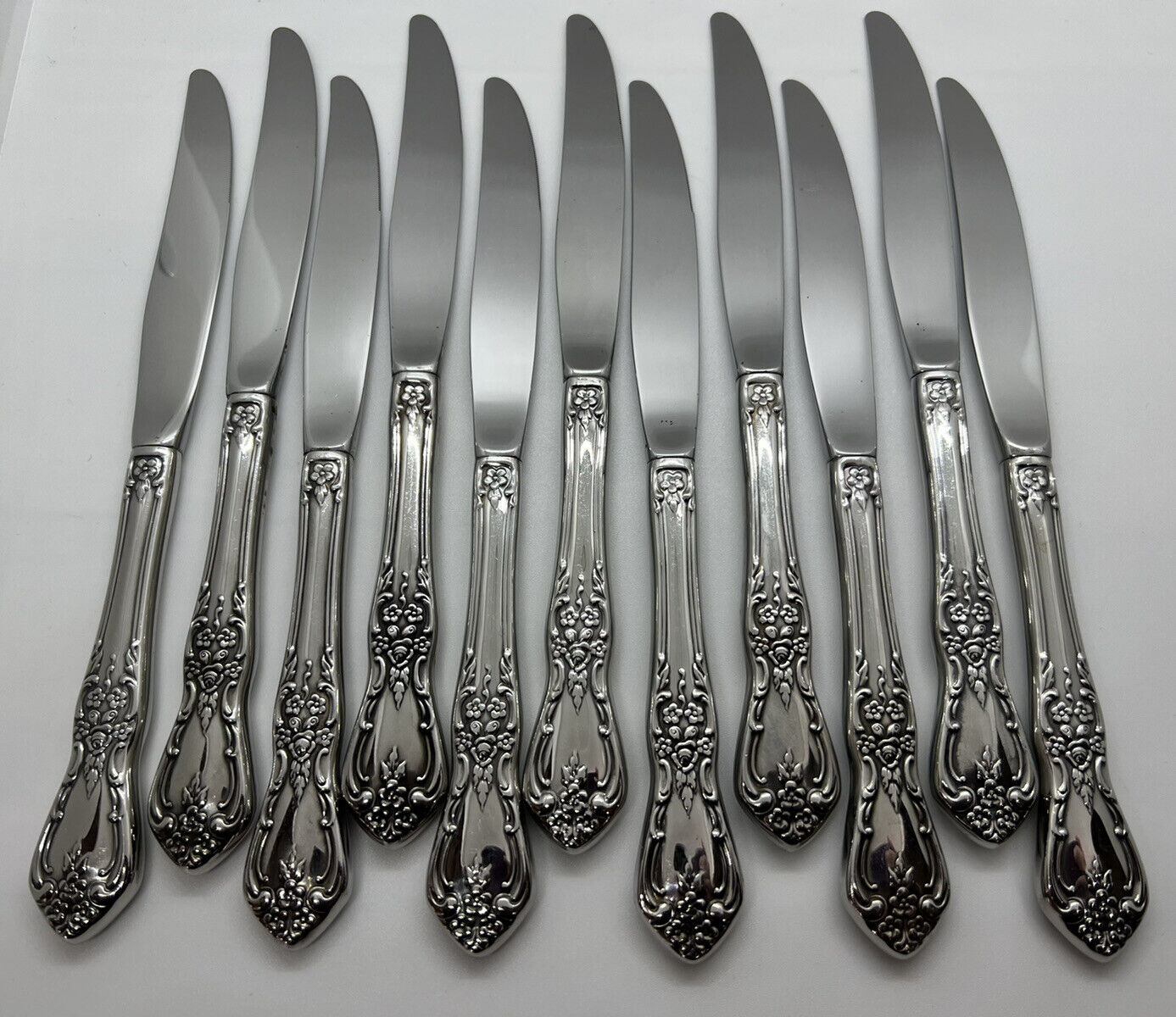The table knife is typically shorter and used for cutting softer foods, while the dinner knife is longer and used for cutting tougher meats. Table knives are shorter and used for cutting softer foods such as vegetables, while dinner knives are longer and used for cutting tougher meats and larger food items.
Different knives have different uses based on their length and purpose. Introducing the right knife to the dining table can make a significant difference while enjoying a meal. Knives are not only essential tools for cutting and dividing food, but they also enhance the overall dining experience.
Two common types of knives used during meals are the table knife and the dinner knife. While they might look similar at first glance, there are distinct differences that set them apart. We will delve into the dissimilarities between table knives and dinner knives, shedding light on their unique roles and functions. So, let’s explore the characteristics of these knives and understand when and how they are used!
What is a table knife used for?
A table knife, also commonly referred to as a dinner knife, is used for cutting softer foods and spreading. It’s not as sharp as kitchen knives, making it safer for table use.
What is a dinner knife?
A dinner knife is essentially the same as a table knife. It’s the knife typically provided in standard table settings and is used for general purposes during the main course.
Which knife to use for dinner table?
In most table settings, the dinner or table knife is the primary knife provided. If multiple knives are set, the rule of thumb is to use knives from the outside in as courses progress. So, for a formal dinner setting with a salad followed by a main course, you’d use the outer knife (salad knife) first and then the dinner knife.
What is the difference between a dinner knife and a salad knife?
The primary difference is their intended use. A salad knife might be smaller than a dinner knife and is meant specifically for the salad course. However, in many settings, particularly less formal ones, the dinner knife can double as the salad knife.
What is another name for a table knife?
Another name for a table knife is a “dinner knife.”
What size is a dinner knife?
The size of a dinner knife can vary based on the design and manufacturer, but typically, a standard dinner knife is about 9 to 10 inches in length.
Understanding The Basics
Table knives and dinner knives have distinct purposes in dining. Table knives are typically used for cutting and spreading, featuring a serrated edge. On the other hand, dinner knives have a smooth edge and are used for eating. These two types of knives have different origins and historical significance.
The idea of table knives originated in medieval times when personal cutlery became popular. Dinner knives, on the other hand, have a longer history, dating back to Ancient Rome. There are also common misconceptions about these knives. For instance, some people believe that table knives should be sharp, when in fact, a serrated edge is preferred.
Understanding these differences can enhance the dining experience and etiquette. So next time you sit down for a meal, take note of the knives on your table and their unique functions.
Exploring The Design And Functionality
Table knives and dinner knives differ in design and functionality. Table knives have specific features including blade length and shape, handle style and material, and cutting edge characteristics. These aspects contribute to the overall design and performance of table knives.
Dinner knives, on the other hand, also possess unique design elements such as blade length and shape, handle style and material, and cutting edge characteristics. These aspects are tailored to suit the requirements of a formal dining experience. The design features of both types of knives play a crucial role in their functionality and aesthetic appeal.
By exploring the nuances in their design, one can appreciate the subtle differences between table knives and dinner knives. Whether it’s the blade shape, handle style, or cutting edge characteristics, each aspect contributes to the distinctiveness of these two types of knives.
Comparing Usage Scenarios
Table knives and dinner knives serve different purposes, making them suitable for various scenarios. Table knives are practical and versatile, perfect for everyday dining and informal occasions. Their functionality allows for easy cutting and spreading of food. On the other hand, dinner knives exude elegance and sophistication, making them more appropriate for formal dining, special events, and celebrations.
Their refined design adds a touch of class to the table setting. While table knives are favored for their practicality, dinner knives are chosen for their aesthetic appeal. Whether you’re enjoying a casual meal with friends or attending a fancy dinner party, understanding the difference between table knives and dinner knives ensures you use the right utensil for the occasion.
Whether it’s the versatility of the table knife or the sophistication of the dinner knife, each has its unique role to play on the dining table.
Analyzing Differences In Etiquette
Table knives and dinner knives have distinct differences in etiquette. Proper handling of table knives involves mastering the correct grip and posture. When eating, it is crucial to execute appropriate gestures and motions. Dinner knives require a different set of etiquettes when it comes to handling them.
In formal settings, following etiquette guidelines is essential. In elaborate meals, it is crucial to display appropriate behavior. Understanding the dissimilarities in the usage of these knives is necessary to navigate various dining scenarios respectfully and elegantly. By observing the proper etiquette for each type of knife, individuals can ensure a seamless dining experience while showcasing their refined manners.
So, next time you find yourself at a formal dinner, remember the nuances between table knives and dinner knives to leave a lasting impression.
Evaluating Cultural Variations
Cultural preferences and regional traditions greatly influence the use and design of table and dinner knives. Throughout Europe, specific customs surround the usage of these utensils. Similarly, Asian cultures have their own unique customs and practices when it comes to table and dinner knives.
The historical and sociocultural factors of each region have played a significant role in shaping these traditions. Moreover, symbolism is often associated with knives in various cultural contexts. Whether it’s the type of knife or the way it is used, these cultural influences are what differentiate table knives from dinner knives across the globe.
Understanding these variations helps to appreciate the diverse perspectives and traditions that exist worldwide.
Comparison Table for: Table Knife vs Dinner Knife
| Criteria | Table Knife | Dinner Knife |
|---|---|---|
| Primary Use | Primarily used for spreading condiments or cutting soft foods. | Designed to cut through firmer foods in main courses. |
| Edge | Usually blunt with a rounded edge. | Might be slightly sharper; some have a semi-serrated edge. |
| Length | Typically shorter and sturdier. | Generally longer and more slender. |
| Appearance | Broader blade with a rounded tip. | Slimmer with a refined look and pointier tip. |
| Common in | Everyday settings and casual dining. | Formal dining settings and upscale restaurants. |
| Blade Thickness | Might be slightly thicker. | Thinner for precise cuts. |
| Material | Standard stainless steel. | Higher-grade stainless steel or with decorative elements. |
| Handle Design | Ergonomic for varied uses. | Complements other formal dining utensils. |
| Price Point | More affordable for everyday use. | More expensive, especially in premium sets. |
| Maintenance | Regular cleaning; generally low maintenance. | Careful cleaning; occasional polishing for some. |
| Ideal For | Everyday meals and basic tasks. | Formal dinners and main courses. |
| Flexibility | Relatively stiff due to its multipurpose nature. | Might be slightly flexible for better slicing of main dishes. |
| Durability | Built for regular use; quite durable. | While durable, more care might be needed to maintain its aesthetic. |
| Safety Features | Rounded tip and blunt edge for safety. | Pointier tip requires more care during handling. |
| Tradition/Cultural Origin | Common in Western settings. | Also rooted in Western dining, but with an emphasis on formal occasions. |
| Weight | Might feel slightly heavier and more robust. | Typically lighter, designed for precise cuts. |
Factors To Consider When Choosing
Choosing the right knife for your dining table involves considering various factors. Firstly, practicality, durability, and maintenance are key considerations. A knife that is easy to handle, long-lasting, and requires minimal upkeep is ideal. Secondly, aesthetics and personal style play a role.
The knife should complement the overall table setting and reflect your personal taste. When it comes to dinner knives, additional factors come into play. The formality of occasions is important; formal gatherings call for more elegant and sophisticated knives. Furthermore, ensuring that the knife matches fine china and tableware is essential for a cohesive and stylish table presentation.
By considering these factors, you can select both table and dinner knives that meet your needs and enhance your dining experience.
Addressing Safety And Maintenance
Table knives and dinner knives have some key differences, particularly when it comes to safety and maintenance. When handling table knives, it is important to follow safety considerations, including adopting safe handling techniques. Proper storage of the knife is also paramount to ensure safety.
On the other hand, dinner knives present their own safety considerations due to their elongated blades. When using dinner knives, it is crucial to handle them with care. Additionally, storing dinner knives properly in formal settings is essential. By addressing these safety and maintenance factors, you can ensure the longevity and safety of both table knives and dinner knives.
Conclusion: Unveiling The Ultimate Distinctions
Table knives and dinner knives have distinct differences in their design and purpose. Table knives typically have a blunt rounded edge, while dinner knives have a pointed tip. The key contrast lies in their functionality: table knives are ideal for spreading and cutting, while dinner knives are primarily used for cutting meat.
When it comes to selecting the right knife, it is crucial to consider the guidelines. Choosing the appropriate knife for specific culinary tasks enhances efficiency and precision. Embracing the diversity in knife usage and appreciation is essential, as different knives serve different purposes in the kitchen.
By understanding the disparities between table knives and dinner knives, individuals can make informed choices based on their intended use. So, next time you set the table or prepare a meal, remember the ultimate distinctions between table knives and dinner knives.
Conclusion
Understanding the difference between a table knife and a dinner knife is essential for proper dining etiquette. While both knives serve the purpose of cutting and spreading food, they have distinct characteristics that set them apart. The table knife is designed with a dull blade and a rounded edge, making it safe and suitable for general use at the dining table.
On the other hand, the dinner knife features a sharp blade and a pointed tip, allowing for precision cuts when dealing with meat and other tougher food items. By using the appropriate knife for each course, you not only showcase a sense of etiquette but also enhance your dining experience.
So, whether you are hosting a formal dinner or enjoying a meal at a fancy restaurant, having a clear understanding of these subtle differences will enable you to navigate the table with confidence and sophistication.

This is Kristina, a passionate content writer, copywriter, and bookworm. Always dedicated to providing informative and accurate product reviews for enjoyable shopping. In my free time, I love spending time in nature and with animals and doing yoga.

